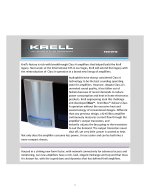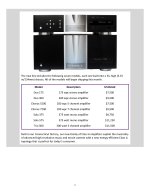You are using an out of date browser. It may not display this or other websites correctly.
You should upgrade or use an alternative browser.
You should upgrade or use an alternative browser.
Krell is releasing new class a amps
- Thread starter Lefisc
- Start date
MDP
Behavior Moderator (be nice police!)
Thanks Barry. That sounds really interesting, I'd like to learn more about that technology they're using.
cmalak
Active member
- Joined
- Apr 10, 2013
- Messages
- 2,304
Mark...it's just another form of sliding bias which has been around for a while. Doesn't mean that their new amps don't sound good, but just means it's nothing new and the technology has been around for a while like most things in hi end audio, the marketing departments proclaim new developments and new technologies, when the reality is anything but. However, having said that, the amp specs and price points look attractive and certainly are worth a listen.
NorthStar
New member
Barry?
Rayooo
Member
- Joined
- Apr 5, 2013
- Messages
- 422
Mark...it's just another form of sliding bias which has been around for a while. Doesn't mean that their new amps don't sound good, but just means it's nothing new and the technology has been around for a while like most things in hi end audio, the marketing departments proclaim new developments and new technologies, when the reality is anything but. However, having said that, the amp specs and price points look attractive and certainly are worth a listen.
exactly what I was thinking.. Krell themselves have done "adaptive bias" in various forms over the years I'd thought. Maybe more to this new design than meets the eye though, time will tell.
Yea the pricing looks un-krell-like to be sure.
MDP
Behavior Moderator (be nice police!)
Mark...it's just another form of sliding bias which has been around for a while. Doesn't mean that their new amps don't sound good, but just means it's nothing new and the technology has been around for a while like most things in hi end audio, the marketing departments proclaim new developments and new technologies, when the reality is anything but. However, having said that, the amp specs and price points look attractive and certainly are worth a listen.
Ok, thanks Cyril !
Lefisc,
While I'm sure somebody else here will be able to provide you with an insanely detailed summary on how Class-A circuits work, I thought I'd offer my take on that particular topology as it pertains to Hi-Fi. Getting right to it!...
Class A circuits: These amplifiers pass current along the voltage rails at all times. They never rest! In fact, many class-A amplifiers will run at full-blast once powered on. So what does this mean? Well, on the downside, it means that these amps will consume a massive amount of power. If you find yourself fretting over your power bill and/or personal carbon footprint, then yeah, these amps probably aren't for you. Naturally, any product that consumes small rainforests for fuel is bound to bring forth other implications. For Class-A amps, those drawbacks come in the form of heat and cost. Since these amps pass along a good amount of current at all times, you can expect them to run hot to the touch. This usually isn't a problem in the colder months. But when it gets warm...well, let's just say that listening au' naturale becomes less of a lifestyle choice and more a function of necessity! haha Also, these amplifiers tend to be expensive to build (mostly due to the need for beefy heat sinks and transformers). So if you want 100wpc of pure Class-A love, then be prepared to fork over the kinda cash that Mike regularly pulls from his wallet.
Don't fret though! There are upsides to these amps! And that upside comes in the form of the sound quality. A well executed Class-A amp will sound absolutely marvelous. Powerful as all get out. You'll get this sense of space and presence that few other topologies can adequately match (especially for the same amount of $$$). And subjectively/personally speaking, I find that Class-A amps are practically unmatched when it comes to producing life-like timbre. So in short, they sound awesome, hence why so many audiophiles are willing to tolerate the above compromises.
While I'm sure somebody else here will be able to provide you with an insanely detailed summary on how Class-A circuits work, I thought I'd offer my take on that particular topology as it pertains to Hi-Fi. Getting right to it!...
Class A circuits: These amplifiers pass current along the voltage rails at all times. They never rest! In fact, many class-A amplifiers will run at full-blast once powered on. So what does this mean? Well, on the downside, it means that these amps will consume a massive amount of power. If you find yourself fretting over your power bill and/or personal carbon footprint, then yeah, these amps probably aren't for you. Naturally, any product that consumes small rainforests for fuel is bound to bring forth other implications. For Class-A amps, those drawbacks come in the form of heat and cost. Since these amps pass along a good amount of current at all times, you can expect them to run hot to the touch. This usually isn't a problem in the colder months. But when it gets warm...well, let's just say that listening au' naturale becomes less of a lifestyle choice and more a function of necessity! haha Also, these amplifiers tend to be expensive to build (mostly due to the need for beefy heat sinks and transformers). So if you want 100wpc of pure Class-A love, then be prepared to fork over the kinda cash that Mike regularly pulls from his wallet.
Don't fret though! There are upsides to these amps! And that upside comes in the form of the sound quality. A well executed Class-A amp will sound absolutely marvelous. Powerful as all get out. You'll get this sense of space and presence that few other topologies can adequately match (especially for the same amount of $$$). And subjectively/personally speaking, I find that Class-A amps are practically unmatched when it comes to producing life-like timbre. So in short, they sound awesome, hence why so many audiophiles are willing to tolerate the above compromises.
NorthStar
New member
Man, do those amps look UGLY :cryforjoy:
They look more like new Emotiva amps than Krell.
Inside is a little bit different though, and they use different parts too.
* Btw, one of the higher end Emotiva amps (XPA-1 | X Series Gen 2) is a switchable Class A (60W @ 8Ω) & Class AB (600W @ 8Ω & 1,000W @ 4Ω) monoblock amp.
=> http://shop.emotiva.com/collections/amplifiers/products/xpa-1-300w-x-2
__________
And the even higher end XPR amps Series use Class A/B with optimized Class-H topology.
=> http://shop.emotiva.com/products/xpr1
So if you want 100wpc of pure Class-A love, then be prepared to fork over the kinda cash that Mike regularly pulls from his wallet.
Sent from my iPad using Tapatalk HD
Attachments
NorthStar
New member
Bob?
Class A.
cmalak
Active member
- Joined
- Apr 10, 2013
- Messages
- 2,304
Here is a quick synopsis of the most common forms of amplifier topologies all related to the biasing mechanism of the amplifier that I quickly found through a Google search from HifiVision.com:
If you want to go more in-depth, you can purchase Robert Harley's book (The Complete Guide to High-End Audio: Robert Harley: 9780978649319: Amazon.com: Books) and that has an in-depth section on amplifier topologies. But I thought the above synopsis was a very good and easy to understand explanation of the different types of amplification.
Let's recap what transistors (and vacuum tubes) do when used as amplifiers in stereo equipment. Speech and music can be represented by complex sinewaves. The object of an amplifier circuit is to increase the amplitude (the peaks of the waveform) of a signal, that is they take a small signal's waveform, and make it bigger, while maintaining the smaller signal's detail (this is called linearity).
How does a transistor do this? Well, technically, a transistor has three terminals. A current or voltage applied through two terminals creates and controls a larger current or voltage produced through the third terminal. This allows a small input from say, a line level source, to be amplified to power loudspeakers and create the sound reaching your ears. Vacuum tubes are similar in that after the tube warms up, a signal is usually applied to the "grid" of the tube and the resultant output of the same frequency is at a much higher amplitude.
The key question is "how well do these devices create these larger signals?"
Classes??
By classes of operation, we mean there are several broad types of amplifier that exist, each with a slightly different operational profile, that impacts how it sounds to the ear of most listeners. Of course, some listeners may disagree with how an amp is characterized sonically, but we are talking about general cases here.
Class A
This is the most linear of the classes, meaning the output signal is a truer representation of what was imputed. Here are the characteristics of the class:
The output device (transistor) conducts electricity for the entire cycle of input signal. In other words, they reproduce the entire waveform in its entirety.
These amps run hot, as the transistors in the power amp are on and running at full power all the time.
There is no condition where the transistor(s) is/are turned off. That doesn't mean that the amplifier is never or can never be turned off; it means the transistors doing the work inside the amplifier have a constant flow of electricity through them. This constant signal is called "bias".
Class A is the most inefficient of all power amplifier designs, averaging only around 20.
Because of these factors, Class A amplifiers are very inefficient: for every watt of output power, they usually waste at least 4-5 watts as heat. They are usually very large, heavy and because of the 4-5 watts of heat energy released per watt of output, they run very hot, needing lots of ventilation (not at all ideal for a car, and rarely acceptable in a home). All this is due to the amplifier constantly operating at full power. The upside is that these amps are the most enjoyed of all amplifiers. These amps dig out musical detail, since the transistor reproduces the entire audio waveform without ever cutting off. As a result the sound is cleaner and more linear; that is, it contains much lower levels of distortion.
They are the most accurate of all amps available, but at significant cost to manufacture, because of tight tolerances, and the additional components for cooling and heat regulation.
Class B
In this amp, the positive and negative halves of the signal are dealt with by different parts of the circuit. The output devices continually switch on and off. Class B operation has the following characteristics:
The input signal has to be a lot larger in order to drive the transistor appropriately.
This is almost the opposite of Class A operation
There have to be at least two output devices with this type of amp. This output stage employs two output devices so that each side amplifies each half of the waveform. [li Either both output devices are never allowed to be on at the same time, or the bias (remember, that trickle of electricity?) for each device is set so that current flow in one output device is zero when not presented with an input signal.
Each output device is on for exactly one half of a complete signal cycle.
These amps run cooler than Class A amps, but the sound quality is not as pure, as there is a lot of "crossover" distortion, as one output device turns off and the other turns on over each signal cycle.
This type of amplifier design, or topology, gives us the term "push-pull," as this describes the tandem of output devices that deliver the audio signal to your speakers: one device pushes the signal, the other pulls the signal. They can be less expensive, because one can use two cheap output devices instead of one high-quality one in the design.
As I mentioned before, the input signal has to be lot larger, meaning that from the amplifier input, it needs to be "stepped up" in a gain stage, so that the signal will allow the output transistors to operate more efficiently within their designed specifications. This means more circuitry in the path of your signal, degrading sound even before it gets to the output stage.
Class AB
This is the compromise of the bunch. Class AB operation has some of the best advantages of both Class A and Class B built-in. Its main benefits are sound quality comparable to that of Class A and efficiency similar to that of Class B. Most modern amp designs employ this topology.
Its main characteristics are:
In fact, many Class AB amps operate in Class A at lower output levels, again giving the best of both worlds
The output bias is set so that current flows in a specific output device for more than a half the signal cycle but less than the entire cycle.
There is enough current flowing through each device to keep it operating so they respond instantly to input voltage demands.
In the push-pull output stage, there is some overlap as each output device assists the other during the short transition, or crossover period from the positive to the negative half of the signal.
There are many implementations of the Class AB design. A benefit is that the inherent non-linearity of Class B designs is almost totally eliminated, while avoiding the heat-generating and wasteful inefficiencies of the Class A design. And as stated before, at some output levels, Class AB amps operate in Class A. It is this combination of good efficiency (around 50) with excellent linearity that makes class AB the most popular audio amplifier design.
There are quite a few excellent Class AB amps available. This is the design I recommended for most general-use applications in home and car. Usually, parts choice rivals that of Class A amps, and dollar for dollar these are some of the best values in stereo amplification. There can be some variation in design principle, but generally these are well-designed amps since their function is very well-understood by audio designers.
Class D
These amplifiers are erroneously called "digital" amplifiers by the press and many audio "experts." Here's the skinny on Class D:
While some Class D amps do run in true digital mode, using coherent binary data, most do not.
They are better termed "switching" amplifiers, because here the output devices are rapidly switched on and off at least twice for each cycle.
Depending on their switching frequency, they may be "switched on" or "off" millions of times a second.
Class D operation is theoretically 100% efficient, but in practice, they are closer to 80-90% efficiency.
This efficiency gain is at the cost of high-fidelity.
Think of Class D amps as being similar to a switchable power supply, but with audio signals controlling, or modulating, the switching action. To do this, you use a technology called Pulse Width Modulation (or PWM, a technology found in many CD players).
According to experts, audio signals can be used to modulate a PWM system to create a high power audio amplifier at fairly low voltages using very small components. Class D audio uses a fixed, high frequency signal having pulses that vary in width based on input signal amplitude. So, for example, a deep bass note creates a large pulse in the carrier signal. This can be translated into a musical signal by the on/off nature of the output devices.
Class D amplifiers are generally used for non-high-fidelity, or subwoofer applications.
If you want to go more in-depth, you can purchase Robert Harley's book (The Complete Guide to High-End Audio: Robert Harley: 9780978649319: Amazon.com: Books) and that has an in-depth section on amplifier topologies. But I thought the above synopsis was a very good and easy to understand explanation of the different types of amplification.
Man, do those amps look UGLY :cryforjoy:
They look more like new Emotiva amps than Krell.
+1
I'm surprised they still haven't dropped it
Seems the amps employ adaptive bias, so no true heat wasting and coil burning Class A.
Nelson Pass
New member
- Joined
- Apr 5, 2013
- Messages
- 27
It's 1975 again.
NorthStar
New member
Bias? ...I guess so.
Jack
Active member
I agree with Nelson. It does appear that with Dan gone, they are just circling back to try and reclaim "their glory days" and probably sales.
Nelson Pass
New member
- Joined
- Apr 5, 2013
- Messages
- 27
This is the entertainment industry.
As such, it is also a fashion industry.
Here's some more "everything old is new again"
SONY DEMONSTRATES PASS LABORATORIES? 40th ANNIVERSARY COMMEMORATIVE VFET AMPLIFIER | Sony
As such, it is also a fashion industry.
Here's some more "everything old is new again"
SONY DEMONSTRATES PASS LABORATORIES? 40th ANNIVERSARY COMMEMORATIVE VFET AMPLIFIER | Sony



